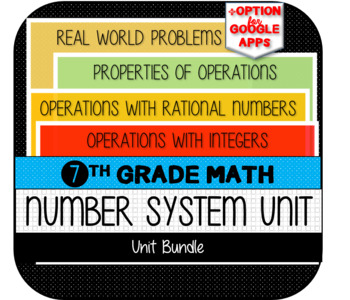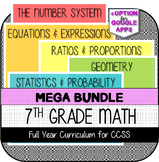7th Grade Math: The Number System UNIT BUNDLE
- Zip
- Easel Activity
What educators are saying
Products in this Bundle (33)
showing 1-5 of 33 products
Bonus
Also included in
- NOTE: Google Apps Options - All assessments & test practice from notes are included as optional Google Forms as well as other supplemental material. However, this curriculum is meant to be primarily PDF print-outs and may not be ideal for "Distance Learning" unless you have special access to PDFPrice $175.00Original Price $250.49Save $75.49
Description
This resource contains the following types of resources for ALL 7th Grade Math Number System standards for CCSS:
1) Notes
2) Practice + Test Practice
3) Supplemental Activities
4) Quizzes
5) Unit Test
Other items included:
Integer Fluency Quizzes
Integer Card Games
Options for Google Apps include 25 links to activities, quizzes, & the Unit Test.
Please note: It may be more helpful to download the BONUS FILE, which contains a .zip of all resources organized & numbered for order of use.
This resource was developed to meet the requirements of the 7th Grade Number System Standards below:
CCSS.MATH.CONTENT.7.NS.A.1
Apply and extend previous understandings of addition and subtraction to add and subtract rational numbers; represent addition and subtraction on a horizontal or vertical number line diagram.
CCSS.MATH.CONTENT.7.NS.A.1.A
Describe situations in which opposite quantities combine to make 0. For example, a hydrogen atom has 0 charge because its two constituents are oppositely charged.
CCSS.MATH.CONTENT.7.NS.A.1.B
Understand p + q as the number located a distance |q| from p, in the positive or negative direction depending on whether q is positive or negative. Show that a number and its opposite have a sum of 0 (are additive inverses). Interpret sums of rational numbers by describing real-world contexts.
CCSS.MATH.CONTENT.7.NS.A.1.C
Understand subtraction of rational numbers as adding the additive inverse, p - q = p + (-q). Show that the distance between two rational numbers on the number line is the absolute value of their difference, and apply this principle in real-world contexts.
CCSS.MATH.CONTENT.7.NS.A.1.D
Apply properties of operations as strategies to add and subtract rational numbers.
CCSS.MATH.CONTENT.7.NS.A.2
Apply and extend previous understandings of multiplication and division and of fractions to multiply and divide rational numbers.
CCSS.MATH.CONTENT.7.NS.A.2.A
Understand that multiplication is extended from fractions to rational numbers by requiring that operations continue to satisfy the properties of operations, particularly the distributive property, leading to products such as (-1)(-1) = 1 and the rules for multiplying signed numbers. Interpret products of rational numbers by describing real-world contexts.
CCSS.MATH.CONTENT.7.NS.A.2.B
Understand that integers can be divided, provided that the divisor is not zero, and every quotient of integers (with non-zero divisor) is a rational number. If p and q are integers, then -(p/q) = (-p)/q = p/(-q). Interpret quotients of rational numbers by describing real-world contexts.
CCSS.MATH.CONTENT.7.NS.A.2.C
Apply properties of operations as strategies to multiply and divide rational numbers.
CCSS.MATH.CONTENT.7.NS.A.2.D
Convert a rational number to a decimal using long division; know that the decimal form of a rational number terminates in 0s or eventually repeats.
CCSS.MATH.CONTENT.7.NS.A.3
Solve real-world and mathematical problems involving the four operations with rational numbers.
LICENSING TERMS: This purchase includes a license for one teacher only for personal use in their classroom. Licenses are non-transferable, meaning they can not be passed from one teacher to another. No part of this resource is to be shared with colleagues or used by an entire grade level, school, or district without purchasing the proper number of licenses.
COPYRIGHT TERMS: This resource may not be uploaded to the internet in any form, including classroom/personal websites or network drives, unless the site is password protected and can only be accessed by students.



